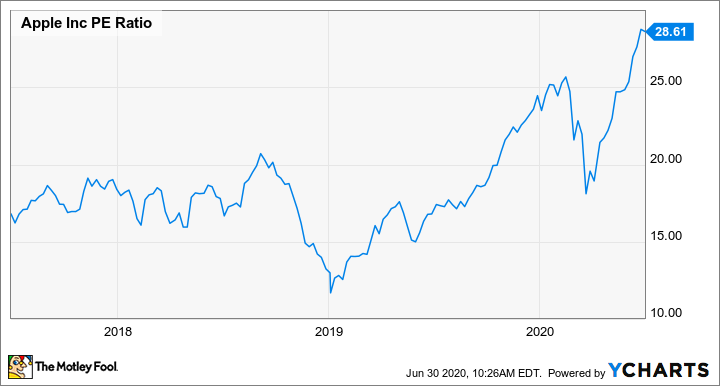Apple's (AAPL -1.22%) stock is hovering near an all-time high after nearly tripling over the past five years, but Wedbush analyst Daniel Ives recently claimed the stock still has a "lot of gas left in the tank" and hiked his price target on the stock from $375 to $425.
Furthermore, Ives believes Apple's stock could eventually hit $500 a share in a "bull case" scenario, buoyed by rebounding sales in China, pent-up demand for the iPhone 12 amid 5G upgrades, and the COVID-19 crisis bolstering its services segment.
Ives also claims the tech giant, which has a market cap of $1.6 trillion, could become the first $2 trillion company by 2021. Investors should always take analysts' forecasts with a grain -- or maybe even a whole pillar -- of salt, but could Apple actually top $500 per share in the near future?

Image source: Apple.
Are the valuations reasonable?
Apple didn't provide any guidance last quarter due to the ongoing impact of the COVID-19 pandemic. However, analysts expect its earnings to rise 4% this year and 20% the next.
At $500 a share, Apple's stock would trade at 40 times this year's earnings and 34 times next year's earnings. Those would be historically high P/E ratios for Apple and would require investors to revalue Apple as a growth stock.
Source: YCharts
For that paradigm shift to occur, Apple would need to accomplish three main goals: convince people to buy the iPhone 12, regain its footing in China, and continue expanding its services segment.
All these goals could prove tough to achieve.
Can Apple overcome its near-term challenges?
The aftershocks of COVID-19 could reduce the spending power of consumers and their appetite for new iPhones later this year. The new iPhones' shift to 5G networks might win over some buyers, but the initial 5G plans could be too pricey, which might convince cash-strapped customers to stick with their 4G phones for at least another year.
To make matters worse, a second wave of COVID-19 infections could force Apple to close its stores again. Apple reportedly shipped 197.4 million iPhones last year, according to Strategy Analytics, but analysts' shipment estimates for 2020 vary widely -- ranging from Cannacord's bearish forecast of 168 million to Wedbush's bullish forecast of up to 215 million. In short, there's no clear consensus regarding Apple's iPhone 12 shipments this year.

Image source: Apple.
Regaining its footing in China could also be challenging, due to tough competition from domestic heavyweights like Huawei, Xiaomi (OTC: XIACF), and Oppo -- all of which have launched 5G phones. The ongoing trade war could also spark a backlash against Apple and other American brands.
Apple's iPhone sales dipped in May, according to CNBC's data from CINNO Research, but retail giant JD.com (JD 0.20%) claimed Apple sold plenty of iPhones during its 618 shopping festival in the first half of June. Therefore, it's still too early to tell if Apple's Chinese business, which generated 16% of its revenues last quarter, is actually recovering.
Apple's services segment faces brutal competition from companies like Netflix (NFLX -9.09%) and Spotify (SPOT -4.62%), as well as antitrust probes of its App Store fees and Apple Pay. Moreover, the high costs of creating and licensing new media content could throttle the unit's operating margins.
Apple could reach $500 ... but not next year
As an Apple investor, I believe the stock could eventually reach $500 a share over the long term. However, Wedbush's expectations are too bullish. They seemingly dismiss competitive threats and unpredictable macro headwinds while potentially overestimating the adoption rate of new 5G phones.






